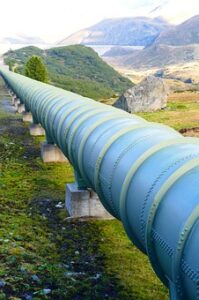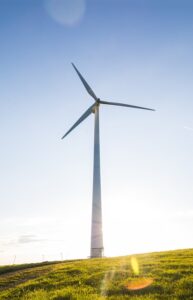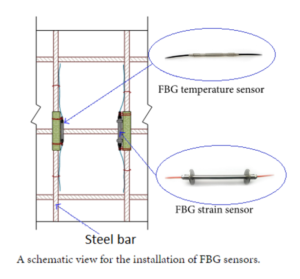 FBG sensors give the opportunity to measure a variety of parameters in conditions where other sensor technologies fail or simply cannot operate. Such FBG sensors have intrinsic advantages, including resistance to electromagnetic interference, non-electrical conductivity, passive measurements, small size and small weight, and the option of multipoint measurements. the reflection wavelength of the FBG (Bragg wavelength) depends on the grating characteristics (period, modulation) and is influenced by the ambient conditions such as strain and temperature. The development of fiber optic devices based on fiber optic sensors for operation in harsh environments (such as for temperatures of up to 1000°С) is becoming an increasingly important field. In the case of temperature sensing the Bragg wavelength is a function of the temperature. This temperature dependence results from changes in the refractive index of the fiber as well as from thermal expansion of the glass material. Many material properties show strong temperature dependence. Examples of such temperature dependencies are dew point, density, electrical conductivity, refractive index, rigidity, and diffusion. Temperature measurement also plays an important role in the health monitoring of electric circuits or civil structures.
FBG sensors give the opportunity to measure a variety of parameters in conditions where other sensor technologies fail or simply cannot operate. Such FBG sensors have intrinsic advantages, including resistance to electromagnetic interference, non-electrical conductivity, passive measurements, small size and small weight, and the option of multipoint measurements. the reflection wavelength of the FBG (Bragg wavelength) depends on the grating characteristics (period, modulation) and is influenced by the ambient conditions such as strain and temperature. The development of fiber optic devices based on fiber optic sensors for operation in harsh environments (such as for temperatures of up to 1000°С) is becoming an increasingly important field. In the case of temperature sensing the Bragg wavelength is a function of the temperature. This temperature dependence results from changes in the refractive index of the fiber as well as from thermal expansion of the glass material. Many material properties show strong temperature dependence. Examples of such temperature dependencies are dew point, density, electrical conductivity, refractive index, rigidity, and diffusion. Temperature measurement also plays an important role in the health monitoring of electric circuits or civil structures.
The main advantages of FBG sensors are their measurement of reflected light, wavelength-encoded sensing, and multiplexing capability. Nowadays there are many types of FBG sensors used for measuring temperature: intrinsic and extrinsic.
Three major types exist:
- The intensity-modulated sensors
Intensity-modulated FBG sensors are based on the principle of letting a physical disturbance such as temperature cause a change in the received light through an optical fiber;
- The phase-modulated sensors
The phase-modulated FBG sensors are based on the principle of comparing the phase of light in the sensing fiber with a reference fiber in an interferometer;
- The wavelength modulated sensors
Wavelength modulated FBG sensors are based on the principle that a physical disturbance such as temperature or strain changes the reflected wavelength of the light.
In general, it should be noted, phase modulated and wave modulated FBG sensors are providing much more accurate measurements than intensity-modulated sensors but at the cost of much more expensive interrogators.
Optromix, Inc. is a U.S. manufacturer of innovative fiber optic products for the global market, based in Cambridge, MA. Our team always strives to provide the most technologically advanced fiber optic solutions for our clients. Our main goal is to deliver the best quality fiber optic products to our clients. We produce a wide range of fiber optic devices, including our cutting-edge customized fiber optic Bragg grating product line and fiber Bragg grating sensor systems. Optromix, Inc. is a top choice among the manufacturers of fiber Bragg grating monitoring systems. If you have any questions, please contact us at info@optromix.com


 Aircraft structures require regular, scheduled inspections and monitoring of all possible hazards due to their special conditions and the principles of their design. Therefore, structural health monitoring is conducted through
Aircraft structures require regular, scheduled inspections and monitoring of all possible hazards due to their special conditions and the principles of their design. Therefore, structural health monitoring is conducted through  A traditional way of monitoring structural health is through the use of piezoelectric transducers; these devices convert pressure to an electric voltage. Transducers are reliable and accurate in most working conditions except in cases of corrosive environments or under high temperatures, above 300° Celsius. Harsh conditions influence reliability. accuracy, and usefulness of transducers in a negative way.
A traditional way of monitoring structural health is through the use of piezoelectric transducers; these devices convert pressure to an electric voltage. Transducers are reliable and accurate in most working conditions except in cases of corrosive environments or under high temperatures, above 300° Celsius. Harsh conditions influence reliability. accuracy, and usefulness of transducers in a negative way. The increased demand for energy due to the growing population has forced the industry to develop new sustainable ways to produce energy. Among new and developing energy technologies are wind turbines. They are widely used to produce energy in many parts of the world. However, there are multiple concerns that are yet to be solved, one of them has been the lack of effective monitoring devices and techniques.
The increased demand for energy due to the growing population has forced the industry to develop new sustainable ways to produce energy. Among new and developing energy technologies are wind turbines. They are widely used to produce energy in many parts of the world. However, there are multiple concerns that are yet to be solved, one of them has been the lack of effective monitoring devices and techniques.  Nowadays, numerous civil infrastructures have been built in metropolitan areas all over the world. The performance of these infrastructures during construction, operation, maintenance, and upgrading is a major concern for society. The use of smart
Nowadays, numerous civil infrastructures have been built in metropolitan areas all over the world. The performance of these infrastructures during construction, operation, maintenance, and upgrading is a major concern for society. The use of smart